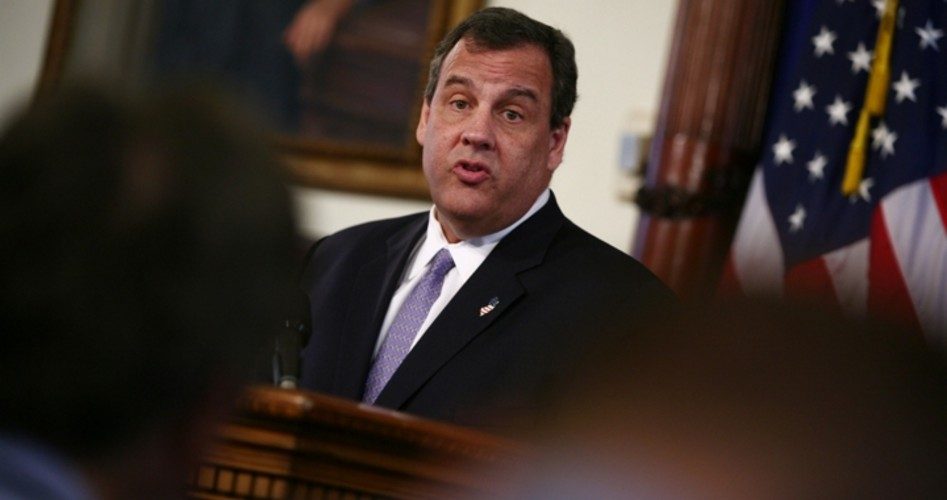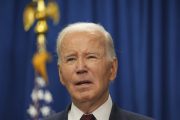
Less than six months into his second term, New Jersey Governor Chris Christie (shown) is having an increasingly difficult time pushing the New Jersey “comeback” theme that gained him reelection in January. This is in addition to the Bridge Gate scandal that has already seen five of his top lieutenants resign or be fired, with three investigations continuing into the matter.
First of all there’s the $807 million budget shortfall in his $33 billion budget that must be filled by the end of June. Then there’s the state’s credit rating, which has been downgraded three times so far this year (it’s only May!) and five times since he took office in 2010. There are suits by unions over his proposal to cut payments to the state’s pension and healthcare plans, which are already approaching $100 billion in unfunded liabilities.
And all of this from a governor whose optimism has consistently exceeded reality. In announcing his budget in March 2012, Christie projected that New Jersey’s revenues would increase by nearly 10 percent year over year as the state’s economy rebounded from the Great Recession. In a speech at the New Jersey Chamber of Commerce’s annual dinner in Washington last November, Christie was positively ebullient about the state of his state:
When we think back on what’s gone on for now nearly five years, the recovery that we have made has been truly exceptional. It’s not complete, but it’s been exceptional.
More people are employed. Revenue in the state budget is higher. Businesses are looking to grow and expand. New businesses are coming into New Jersey.
Unfortunately Christie conveniently overlooked the reality back home. One of his biggest talking points is the more than 130,000 private-sector jobs that have been created during his reign. Compared to other states, this puts New Jersey just above New Mexico, which is in last place in new job creation. Year over year, from March 2013 to March 2014, in a state of 9 million, just 2,200 private-sector jobs were created, tying New Jersey with Mississippi for 48th place.
A closer look at some of these numbers reveals New Jersey’s even more tenuous financial situation. The budget shortfall for the state over the next two years is nearly $2 billion, causing Moody’s Investors Service to note: “With the ongoing pressure of … pension contribution increases and lagging economic performance, the state will be challenged to improve its weak liquidity position.”
That weak liquidity position is just one of four indices that Sarah Arnett looked at in her working paper for the Mercatus Center on the states’ fiscal conditions published in January. She measured short-term, intermediate-term, and long-term solvency for all states and concluded that New Jersey was dead last among the 50 states. In simple terms, New Jersey’s ability to pay its bills on time, its ability to budget its expenses without a deficit, and its ability to pay for all of its long-term costs and commitments for years into the future have put the state at the very bottom of her list.
Her analysis, based on 2012 numbers, fails to account for rising healthcare costs under ObamaCare or the increasing cost of borrowing as the state’s credit rating downgrades force bond buyers to demand more risk premium in their returns.
The real challenge facing Christie, however, is how his state’s economic performance stacks up against other states run by Republican governors who might also be looking at the presidential race in 2016: Rick Perry in Texas, Scott Walker in Wisconsin, John Kasich in Ohio, Mike Pence in Indiana, and Bobby Jindal in Louisiana. In five of six separate categories New Jersey comes in last.
In private-sector jobs created since February 2010, New Jersey’s rate is half that of the lowest of the others and one-quarter of those in Texas. In total jobs lost or gained since the start of the Great Recession, New Jersey underperforms all of the competition. In increases in exports over the last four years, New Jersey remains at the bottom, barely one-quarter of those generated in Bobby Jindal’s Louisiana. New Jersey’s housing prices remain 20 percent below where they were before the housing crash, while Texas’ housing prices have actually increased five percent in that period.
Only in household median income has New Jersey held its own, down just 0.5 percent from 2007-2012, compared to an 18 percent decline in John Kasich’s Ohio.
Christie’s problem can be measured another way, with equally dismal results. According to Arnett, New Jersey’s per-capita budget deficit was $727 in 2012, the worst in the country (the average of all states that year was actually a per-capita surplus of $364), while the state’s long-term liabilities, per capita, were almost $8,000, three times the national average. She concluded that New Jersey’s problems result from “tax revenues [that] have not kept up with expenditures, use of budget practices that only appeared to balance the annual budget, and [the state’s] significant debt levels.”
In a word, comparing promises to performance, New Jersey Governor Chris Christie has done little to turn his state around. Since being elected chairman of the Republican Governors Association in November, Christie is finding that in touting his state’s “exceptional comeback” as he crisscrosses the country in his fundraising efforts, he is losing credibility. Continuing to put a happy face on New Jersey’s decline during his administration will serve to remove him from serious consideration as a Republican presidential contender in 2016.
A graduate of Cornell University and a former investment advisor, Bob is a regular contributor to The New American magazine and blogs frequently at www.LightFromTheRight.com, primarily on economics and politics. He can be reached at [email protected].


